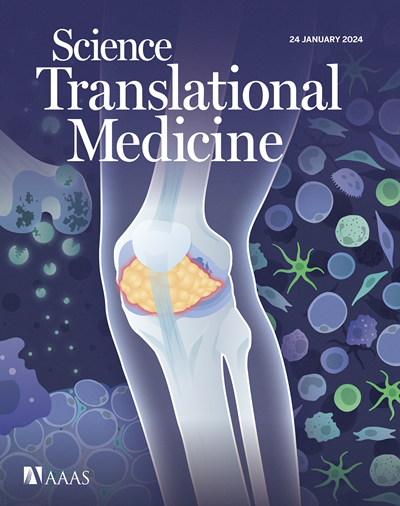Collagen V regulates renal function after kidney injury and can be pharmacologically targeted to enhance kidney repair in mice
IF 15.8
1区 医学
Q1 CELL BIOLOGY
引用次数: 0
Abstract
Kidney fibrosis determines clinical outcomes in individuals with chronic kidney disease (CKD). The stoichiometric ratio of collagens in renal scar differs from that of healthy kidney extracellular matrix (ECM), but the functional importance of altered collagen types in injured kidneys remains unclear. Using human population studies, we show that circulating protein and renal mRNA amounts of collagen V A1 (COL5A1) exhibited associations with kidney disease and incident CKD risk. We show that Col5a1 regulates the degree of postinjury fibrosis and renal function. Mice with conditionally knocked out Col5a1 (Col5a1 CKO) exhibited decreased renal function and greater renal fibrosis after dietary adenine- or ureteric obstruction–mediated kidney injury. Renal fibroblasts in Col5a1 CKO animals up-regulated the profibrotic αvβ3 integrin. Inhibition of αvβ3 signaling with a small molecule, cilengitide, rescued postinjury renal function in Col5a1 CKO animals. Using the hybrid mouse diversity panel that comprises 100 diverse inbred strains of mice, we observed that gene expression of Col5a1 after injury exhibited genetic variation across 100 strains. Strains with low Col5a1 expression after injury exhibited worse renal function compared with animals that had higher degrees of expression. We next measured Col5a1 expression in peripheral blood mononuclear cells in mice to identify nonresponder strains that did not have increased Col5a1 expression after kidney injury. We observed that administration of cilengitide in nonresponder strains significantly rescued postinjury renal fibrosis and function. These studies point to the feasibility of precision medicine approaches to target Col5a1 for enhancing renal repair.
求助全文
约1分钟内获得全文
求助全文
来源期刊

Science Translational Medicine
CELL BIOLOGY-MEDICINE, RESEARCH & EXPERIMENTAL
CiteScore
26.70
自引率
1.20%
发文量
309
审稿时长
1.7 months
期刊介绍:
Science Translational Medicine is an online journal that focuses on publishing research at the intersection of science, engineering, and medicine. The goal of the journal is to promote human health by providing a platform for researchers from various disciplines to communicate their latest advancements in biomedical, translational, and clinical research.
The journal aims to address the slow translation of scientific knowledge into effective treatments and health measures. It publishes articles that fill the knowledge gaps between preclinical research and medical applications, with a focus on accelerating the translation of knowledge into new ways of preventing, diagnosing, and treating human diseases.
The scope of Science Translational Medicine includes various areas such as cardiovascular disease, immunology/vaccines, metabolism/diabetes/obesity, neuroscience/neurology/psychiatry, cancer, infectious diseases, policy, behavior, bioengineering, chemical genomics/drug discovery, imaging, applied physical sciences, medical nanotechnology, drug delivery, biomarkers, gene therapy/regenerative medicine, toxicology and pharmacokinetics, data mining, cell culture, animal and human studies, medical informatics, and other interdisciplinary approaches to medicine.
The target audience of the journal includes researchers and management in academia, government, and the biotechnology and pharmaceutical industries. It is also relevant to physician scientists, regulators, policy makers, investors, business developers, and funding agencies.
 求助内容:
求助内容: 应助结果提醒方式:
应助结果提醒方式:


